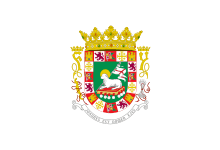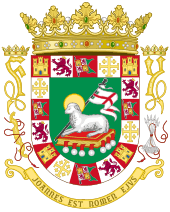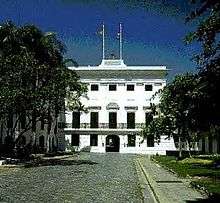Governor of Puerto Rico
| Governor of Puerto Rico
Spanish: Gobernador de Puerto Rico | |
|---|---|
 Seal of the Governor | |
 Standard of the Governor | |
| Style |
His Excellency diplomatic Mister Governor when presiding First Executive third person |
| Residence | La Fortaleza |
| Term length | Four years, no term limit |
| Inaugural holder | Juan Ponce de León |
| Formation | 1508 |
| Salary | $70,000 (2013)[1] |
| Website |
fortaleza |
 |
|---|
| This article is part of a series on the politics and government of Puerto Rico |
|
The Governor of Puerto Rico (Spanish: Gobernador de Puerto Rico) is the head of government of Puerto Rico and, by its nature, constitutes the executive branch of the government of the island. He is also the commander-in-chief of the island's military forces, the Puerto Rico National Guard.
The governor has a duty to enforce state laws, to convene the Legislative Assembly, the power to either approve or veto bills passed by the Legislative Assembly, to appoint government officers, to appoint Justices, and to grant pardons. Since 1948, the governor has been elected by the people of Puerto Rico. Prior to that, the governor was appointed either by the King of Spain (1510–1898) or the President of the United States (1898–1948).
Article IV of the Constitution of Puerto Rico vests the executive power on the governor and empowers him with the faculty to appoint officers. Law No. 104 of 1956[2] empowers him with the faculty to delegate functions. These two faculties in conjunction allow the governor to delegate most of his functions while continuing to be the maximum officer and head of government.
Most of the governor's functions are delegated to the Chief of Staff, who is charged with managing and overseeing all the executive departments and almost all executive agencies. The budget is delegated to the Director of the Office of Management and Budget while centralized planning is delegated to the President of the Planning Board. This effectively makes the governor a political figure rather than an administrative one, allowing him to set the vision for what the island should be and where it should go rather than having to be involved in its day-to-day operations. Historically, however, governors tend to be heavily involved in the day-to-day operations of the government in both internal and external affairs.
History
The first known and recorded heads of government in the history of Puerto Rico were the caciques, the tribal chiefs of the natives known as Taínos that inhabited the island before the arrival of Spaniards. It is believed that the cacique rank was apparently established through democratic means. His importance in the tribe was determined by the size of his tribe rather than his warlord skills, since the Taínos were mostly a pacifist culture. Agüeybaná I is the most-well known cacique as he was the one governing all others when the Spaniards arrived in 1493 although many others existed during his period, as well as before and after him.
Juan Ponce de León was appointed as the first Governor of Puerto Rico in 1508 and assumed the post in 1510. In 1579, after several others had already served as governor, Juan Ponce de León II became the first person born in Puerto Rico to assume, temporarily, the governorship of Puerto Rico. He served until, who assumed the governorship of the island that same year.[3]
In 1948, Luis Muñoz Marín became the first Puerto Rican elected Governor of Puerto Rico.
Powers
The governor is head of the government of Puerto Rico. He has the power to veto any number of projects that the Puerto Rican Legislature wishes to pass. The governor also has the power to appoint the members of his cabinet, who in turn must be ratified by the Legislature. The governor also has the power to appoint Justices to the Supreme Court and all the lower courts of the island.
The governor must address the legislature at the beginning of each year to present two speeches, one is the State of the Commonwealth speech and another in which the governor presents the "Recommended Budget" for the next fiscal year, in which the governor proposes to the state legislature a budget for the consideration of said body. He is also the commander-in-chief of the Puerto Rico National Guard and the chief diplomat.

Eligibility
On July 25, 1952, the Constitution of Puerto Rico was enacted by Governor Muñoz Marín after the approval by Congress and the President of the United States. Pursuant to section Three, Article IV of the Constitution of Puerto Rico, the governor must be a citizen of the United States, a resident of Puerto Rico for five consecutive years prior and at least 35 years old at the time of the election.
The governor serves a four-year term which begins on the second day of January after the year of his election and ends on the date his successor takes office. Consecutive service is unlimited, according to the Constitution of the Island. As an example Luis Muñoz Marín, its first elected governor, served for four consecutive terms from 1949 to 1965; the Constitution of the Commonwealth was ratified by the people of Puerto Rico in 1952.
Elections
The governor is elected by a direct vote from the people. The Puerto Rico Elections Code states that if the margin of victory of a candidate is less than 0.5% of the votes a full recount of the election must take place. So far, only in the gubernatorial elections of 1980 and 2004 has a recount taken place.
The last elected governor was Ricardo Rosselló who was sworn into office on January 2, 2017 at the age of 37.
Succession
Upon the death, resignation, or removal from office (by impeachment and conviction) of a sitting governor, the Secretary of State would then take the office of governor until the end of the four-year term. In case the Secretary of State is unwilling or unable to assume it, the Secretary of Justice would temporarily assume the governorship, followed by the Secretary of Treasury, the Secretary of Education, the Secretary of Labor and Human Resources, the Secretary of Transportation and Public Works, the Secretary of Economic Development and Commerce, the Secretary of Health and the Secretary of Agriculture, until the Legislative Assembly meets to elect by majority vote of all of its members a governor for the rest of the term. Other provisions exist for the transition between an incumbent governor and a governor-elect.[4]
Contrary to some U.S. states, if the governor is temporarily away from Puerto Rico, the Secretary of State, or in his absence the highest ranking Cabinet member in the line of succession, becomes acting governor until the governor's return. In decades past, when off-island gubernatorial travel was infrequent, the powers of the governorship rarely devolved upon the Secretary of State or other Cabinet officers. More accessible travel have turned the acting governorship a much more common occurrence. During recent times, not only Secretary of State frequently served as acting governor, but the Secretary of Justice, and Secretary of Treasury as well.
References
- ↑ "CSG Releases 2013 Governor Salaries". The Council of State Governments. June 25, 2013. Retrieved November 23, 2014.
- ↑ Law No. 104 of 1956
- ↑ Casa Blanca reveals centuries of San Juan history Archived 2009-06-14 at the Wayback Machine.
- ↑ "Archived copy". Archived from the original on 2011-11-14. Retrieved 2011-10-30.
.jpg)